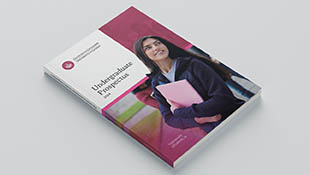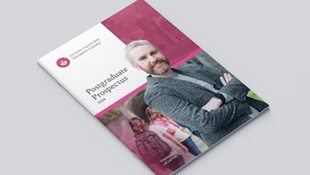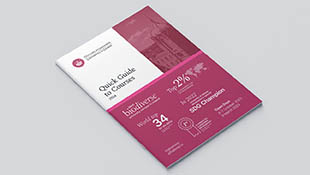-
Courses

Courses
Choosing a course is one of the most important decisions you'll ever make! View our courses and see what our students and lecturers have to say about the courses you are interested in at the links below.
-
University Life

University Life
Each year more than 4,000 choose University of Galway as their University of choice. Find out what life at University of Galway is all about here.
-
About University of Galway

About University of Galway
Since 1845, University of Galway has been sharing the highest quality teaching and research with Ireland and the world. Find out what makes our University so special – from our distinguished history to the latest news and campus developments.
-
Colleges & Schools

Colleges & Schools
University of Galway has earned international recognition as a research-led university with a commitment to top quality teaching across a range of key areas of expertise.
-
Research & Innovation

Research & Innovation
University of Galway’s vibrant research community take on some of the most pressing challenges of our times.
-
Business & Industry

Guiding Breakthrough Research at University of Galway
We explore and facilitate commercial opportunities for the research community at University of Galway, as well as facilitating industry partnership.
-
Alumni & Friends

Alumni & Friends
There are 128,000 University of Galway alumni worldwide. Stay connected to your alumni community! Join our social networks and update your details online.
-
Community Engagement

Community Engagement
At University of Galway, we believe that the best learning takes place when you apply what you learn in a real world context. That's why many of our courses include work placements or community projects.
Contextual Behavioural Science Group
Contextual Behavioural Science (CBS) Group
The NUI Galway Contextual Behavioural Science (CBS) group, led by Dr. Ian Stewart, has links with a number of other CBS research centres in Ireland (e.g., the University College Dublin group led by Dr. Louise McHugh) as well as with researchers conducting CBS relevant research internationally.
Contextual Behavioural Science (Hayes, 2013) is an approach to psychology and to science more generally (Hayes, Wilson et al., 2012) that takes action in context as its core focus and sees the achievement of prediction and influence over behaviour as a key goal. While this approach has its roots in behaviour analysis, it extends beyond the latter in its emphasis on the adoption of a purely functional approach most notably with respect to complex human responding. This has resulted in the development of an empirically based, comprehensive account of human language and cognition known as Relational Frame Theory (RFT; Hayes, Barnes-Holmes & Roche, 2001; Dymond & Roche, 2013) as well as to increasingly well-supported implementations of this approach in various domains of human psychology including psychopathology (i.e., Acceptance and Commitment Therapy [ACT]; Hayes, Strosahl & Wilson, 1999; 2011) and education (see e.g., Rehfeldt & Barnes-Holmes, 2009).
Relational Frame Theory (RFT)
The majority of the research of the NUI Galway Contextual Behavioural Science (CBS) group is centred on Relational Frame Theory (RFT), the contextual behavioural psychological approach to human language and cognition. RFT is supported by a comprehensive basic experimental research program involving by now over 150 empirical studies.
RFT suggests that language is based on the learned ability to perform abstract or arbitrarily applicable relational responding (AARR). For example, imagine I tell a young child that “Jim has more cookies than Alice and Alice has more cookies than Iris”. By a certain age, most typically developing children would be able to derive multiple new relations including, for instance, “Jim has more than Iris” and “Iris has less than Jim”. The child would be able to do this despite the fact that the latter responses have not been explicitly taught and that, as this is a hypothetical scenario, there are no actual people or cookies visible as a basis for these performances. From an RFT perspective, what is happening is that I am presenting the child with a contextual cue (i.e., “more”) that has been previously established in their learning history as controlling a particular pattern of generalized relational responding. When that cue is presented, that response pattern is then brought to bear on any arbitrarily chosen set of stimuli no matter what their non-arbitrary properties such that all of the stimuli are brought into a coherent set of relations with each other. In this particular case, it is brought to bear on the arbitrary stimuli “Jim”, “Alice” and “Iris” but I could use any names; hence the term “arbitrarily applicable relational responding”.
Within RFT, patterns of AARR such as this are called relational frames. RFT suggests the existence of a variety of these frames including sameness (or coordination, e.g., “A = B” or “This object is an apple”), comparison (e.g., “C is more (or bigger) than D”), opposition (“black is the opposite of white”), distinction (“this is not the same as that”), hierarchy (“a whale is a type of mammal”), analogy (“A is to B as C is to D”), perspective (“I am here and you are there”), time (“spring comes before summer”) and others. Furthermore, RFT researchers have provided an increasing quantity of empirical evidence both that people (from early childhood onwards) respond in accordance with a variety of these frames and that they can be trained up when weak or absent.
RFT suggests that AARR or relational framing (in its multiple varieties) is the ability that underlies human language and that facilitates the flexibility, generativity, and rapid acquisition that characterize normal language development. AARR in accordance with sameness (coordination) is the first such pattern to emerge, and there is empirical research with infants charting the emergence of this pattern as well as demonstrating how it can be explicitly trained (Lipkens, Hayes & Hayes, 1993; Luciano, Gomez-Becerra, & Rodriguez-Valverde, 2007). As suggested, in typical development, many other patterns of AARR are subsequently learned. For example, consider how AARR in accordance with comparison or more/less relations might be acquired. In this case, the child likely first learns to choose a physically greater quantity (e.g., of cookies, candies etc.) in the presence of auditory stimuli such as ’more’ and to choose the physically lesser quantity in the presence of stimuli such as ’less’. Then through exposure to multiple exemplars of this type of pattern in the presence of these contextual cues with a variety of different objects in a variety of different situations, the relational response becomes abstracted such that it can be applied in conditions in which there is no obvious formal relation; for instance, the example with the cookies given above.
Our Research
The four main areas of focus of our research group include empirical work into early language learning; implicit cognition and the IRAP; complex language and cognition; psychopathology & psychotherapy.
Early Language Learning
One focus of our work is the assessment and training of relational framing in young children. One methodology that we have developed for that purpose is the computer-based Training and Assessment of Relational Precursors and Abilities (TARPA).
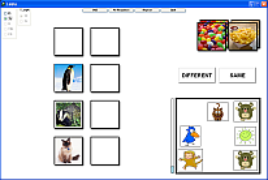
The latter assesses same, different and opposite relations on a dimension from simple (formally based) levels of responding up to abstract arbitrarily applicable (relational framing) levels. At all levels, it assesses auditory, visual and auditory visual relations, and with respect to the relational framing level, it allows consideration of each of the three properties of framing (mutual entailment, combinatorial entailment and transformation of functions) separately. We are employing methods other than the TARPA also including table top matching to sample (MTS) and relational grid protocols, the online SMART (Strengthening Mental Abilities with Relational Training) procedure and the Relational Evaluation Procedure.
Implicit Cognition and IRAP
Since the mid-1990s, implicit cognition has been a central focus of social psychological research and has developed into a distinctive topic in its own right in psychological science more broadly. RFT accounts for implicit cognition and its attendant effects in terms of relational responding and over the last ten years, RFT researchers have developed both a theoretical model of implicit cognitive phenomena (Relational Elaboration and Coherence Model; Barnes-Holmes, Barnes-Holmes, Stewart & Boles, 2010) as well as an RFT-based procedure (Implicit Relational Assessment Procedure; IRAP) for capturing and exploring these phenomena.
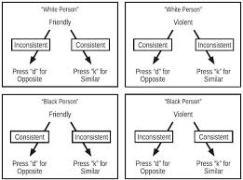 Members of our group have published a number of IRAP studies. For example, one theme of our work has been the use of the IRAP to measure implicit weight-related attitudes. More recently, members of our group has been collaborating with researchers at NUI Maynooth to develop the IRAP into a measure of deictic or perspective-taking relations
Members of our group have published a number of IRAP studies. For example, one theme of our work has been the use of the IRAP to measure implicit weight-related attitudes. More recently, members of our group has been collaborating with researchers at NUI Maynooth to develop the IRAP into a measure of deictic or perspective-taking relations
Complex Language and Cognition
RFT explains language and complex cognitive phenomena (e.g., problem solving, analogical reasoning, classification, rule-governed behaviour, self-awareness, perspective taking etc.) in terms of learned patterns of relational framing. Accordingly, researchers working within the RFT paradigm have begun to successfully model and investigate a variety of cognitive phenomena in these terms.
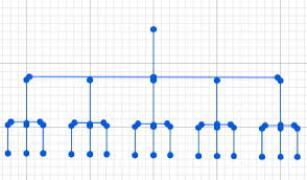
Over the last number of years, researchers NUI Galway CBS group have examined a subset of these processes including analogical reasoning, hierarchical classification and problem solving.
Psychopathology & Psychotherapy
RFT articulates both theoretically and empirically with Acceptance Commitment Therapy (ACT), the CBS-based approach to psychological well-being which is being applied successfully across diverse domains of human activity. In ACT, every component of the technology is connected conceptually to RFT, and several of these components (e.g., avoidance, perspective-taking, defusion and values) have been studied empirically.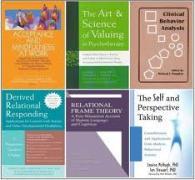
The work of the NUI Galway CBS group has focused on a number of aspects of RFT modelling of ACT relevant processes including deictic relational responding, derived thought suppression and defusion.
Members of the NUI Galway Contextual Behavioural Science (CBS) group include the following:
Dr. Ian Stewart 
Ian Stewart has been a member of academic staff at NUI Galway since August, 2002. His current research focuses on the analysis of a variety of aspects of language and cognition from an RFT perspective. His specific interests include the use of RFT protocols to model and investigate (i) early language learning (TARPA); (ii) forms of complex cognition; (iii) implicit cognition (IRAP); (iv) psychopathology and psychotherapy.
Dr. Naoko Kishita (Post-doctoral researcher)
After completing her PhD at Doshisha University in 2013, Dr. Kishita used postdoctoral funding awarded by the Japan Society for the Promotion of Science (JSPS) to move to NUI Galway to begin conducting research as part of the Contextual Behavioural Science group. Her current research is focused on the use of RFT to model and investigate key processes in psychopathology and psychotherapy. More specifically, she is investigating the nature of cognitive defusion in terms of the patterns of relational framing that may be involved. Furthermore, she is using the IRAP as a procedure for establishing relevant psychological functions as well as for gauging potential outcomes of the defusion intervention.
Siri Ming (PhD student)
Based in Baltimore, Siri is a Board Certified Behaviour Analyst who provides consultation and distance-based supervision for EIBI programs for children with autism. Her clients have included individuals, agencies, and schools located throughout the US and Canada, the UK, the Middle East, India, and Australia. As adjunct faculty with The Chicago School of Professional Psychology she also teaches graduate level coursework in Verbal Behaviour and supervises practicum students on related research projects. She is currently enrolled on the Structured PhD in Applied Behaviour Analysis and her work involves assessing and training relational frames of coordination and distinction with visual and auditory stimuli as a basic foundation for establishing conversational generativity in young children with autistic spectrum disorder.
Corinna Stewart (PhD student; co-supervised by Dr. Yvonne Barnes-Holmes, NUI Maynooth)
Since graduating from NUI Maynooth, Corinna has spent time working as (i) a research associate with ’Commit and Act’, an organisation that trains health care workers in Sierre Leone in Acceptance and Commitment (ACT); (ii) a research assistant working for the Health Service Executive (HSE) in Dublin on assessment of mental health recovery; and (iii) a research assistant in the University of Glasgow recruiting and completing clinical assessments of individuals with schizophrenia. She is currently enrolled on the Structured PhD in Perception Cognition and Action (PCA) and her research is focused on the development and validation of a version of the IRAP adapted for RFT-based assessment and training of individuals with schizophrenia.
Laura Moran (PhD student)
After completing a Masters in Applied Behaviour Analysis at NUI Galway, Laura graduated to the structured PhD programme in the same area. Her doctoral research has been a continuation and expansion of her work in the context of her Master’s thesis. The focus of this work is the development and validation of the TARPA (Training and Assessment of Relational Precursors and Abilities) protocol as a computer-based instrument for assessing and training coordinate relational framing in young children including both typically developing as well as with developmental delay.
Shane McLoughlin (PhD student)
After completing a B.Sc. (Hons.) in Applied Psychology at I.A.D.T. Dun Laoghaire, Shane pursued his interests in the philosophy of psychology and relational frame theory and enrolled on the Structured Ph.D. in Perception, Cognition, & Action (PCA) at NUI Galway. His research is focused on extending the RFT investigation of relating relational networks. Up to this point, this work has focused mainly on analogical reasoning, the best known form of relating of relations. Shane’s work will include the investigation of his phenomenon; however, he is also interested in extending this work into the analysis of the derivation of relations of non-equivalence between relational networks.
Teresa Mulhern (PhD student)-128x180.jpg)
After completing a Masters in Applied Behaviour Analysis at NUI Galway, Teresa graduated to the structured PhD programme in the same area. Her doctoral research is focused on hierarchical classification in children. Classification refers to grouping stimuli according to their physical or functional similarity while hierarchical classification involves classifying classes themselves into higher order classes. Within RFT it is thought to involve both containment and hierarchical relations. Teresa’s doctoral work involves developing and pilot testing an RFT-based instrument to assess and train ’containment’ and ’hierarchical’ relational framing skills in typically developing children aged 3 to 7.
Jennifer Hayes (PhD student)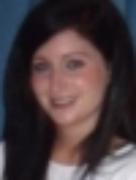
After completing a Masters in Applied Behaviour Analysis at NUI Galway, Jennifer graduated to the structured PhD programme in the same area. Her doctoral research is focused on the development of relational evaluation procedure (REP) type methodologies for assessing and training non-arbitrary and arbitrarily applicable relational responding in a number of different age groups of children including participants at the early, middle and older childhood stages (more specifically children 2-4, 6-7 and 9-10 years of age).
Brian Slattery (PhD student)
Brian Slattery’s work has been focused on conceptualising and modelling hierarchical classification using RFT. Classification refers to grouping stimuli according to their physical or functional similarity while hierarchical classification involves classifying classes themselves into higher order classes. Brian’s experimental work has involved testing a possible RFT model of this phenomenon for the presence of properties claimed to be important within the mainstream psychology literature.
Gabriel Bourke (PhD student; co-supervised by Dr. Tony Hall, Dept. of Education, NUIG)
Working under the co-supervision of Dr. Tony Hall of the department of education, and enrolled on the Structured PhD in Learning Sciences, Gabriel is investigating the effect of SMART (Strengthening Mental Abilities using Relational Training) relational training on reading and other intellectual abilities in access students at NUI Galway.
James Duguid (PhD student; co-supervised by Dr. Joseph Ciarriochi, Wollongong, Australia)
Working under the co-supervision of Dr. Joseph Ciarriochi of University of Western Sydney, Australia, James is using the IRAP to investigate effects of context on weight-related implicit attitudes.








